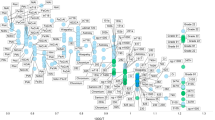Abstract
WE have investigated some of the electrochemistry of two 12 per cent chromium martensitic steels while undergoing cracking in acid media. Since it is known that these steels can be made to crack through hydrogen embrittlement as well as by stress corrosion, we were curious as to the cause of cracking in 1 per cent hydrochloric acid with 1 per cent dissolved selenium dioxide. Following the procedure of Brown1, increasingly larger polarizing currents, both anodic and cathodic, were applied to stressed beam specimens to determine which reaction hastened the time to failure. From these results we concluded that the cracking in this medium was by hydrogen embrittlement. Further proof was obtained by substituting sulphuric acid for hydrochloric acid (to eliminate the possible stress corroding influence of the chloride ion) without any change in the pattern of results. Simultaneously with our tests on the effect of applied currents on time to fracture, potential-time curves were automatically recorded. The rather unusual changes in potential we observed are primarily the reason for this communication.
This is a preview of subscription content, access via your institution
Access options
Subscribe to this journal
Receive 51 print issues and online access
$199.00 per year
only $3.90 per issue
Buy this article
- Purchase on Springer Link
- Instant access to full article PDF
Prices may be subject to local taxes which are calculated during checkout
Similar content being viewed by others
References
Brown, B. F., Rep. Naval Res. Lab., Progress, 40 (1959).
Hoar, T. P., and Hines, J. G., J., Iron and Steel Inst., 182, 124 (1956).
Parkins, R. N., and Brown, A., J. Iron and Steel Inst., 193, Part 1, 45 (1959).
Engell, H. J., and Bäumel, A., “Physical Metallurgy of Stress Corrosion Fracture”, 341 (Interscience Pub., 1959).
Author information
Authors and Affiliations
Rights and permissions
About this article
Cite this article
SCHARFSTEIN, L., EISENBROWN, C. Potential-Time Curves obtained during the Stress Cracking of Metals. Nature 188, 572–573 (1960). https://doi.org/10.1038/188572a0
Issue Date:
DOI: https://doi.org/10.1038/188572a0
Comments
By submitting a comment you agree to abide by our Terms and Community Guidelines. If you find something abusive or that does not comply with our terms or guidelines please flag it as inappropriate.



